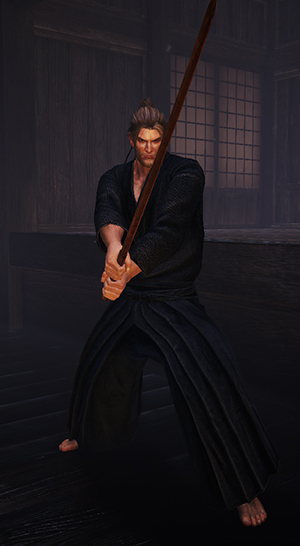
Waki-gamae was a popular stance before there were restrictions regarding blade length. It involves hiding the sword behind the practitioner's body, exposing only the sword's pommel to the practitioner's opponent. Waki-gamae is the side posture used in kenjutsu. Hassō-no-kamae is a purely offensive posture, receiving its namesake for the emphasis is places on situational awareness. With this posture, the practitioner places his or her left foot in front, while holding their sword upright in a near-vertical position with the hilt in front of their right shoulder. Hassō-no-kamae is the "eight-sided" posture used in kenjutsu. Gedan-no-kamae is classified as a style of chūdan-no-kamae, so it creates the perception of a defense posture but allows the practitioner to deflect blows and perform counterattacks. To perform this posture, the practitioner places his or her sword out in front of their body, pointing it at either the waist (for kendo) or the knee (for kenjutsu). Gedan-no-kamae is the low posture used in kenjutsu. There are actually different styles of jōdan-no-kamae: one involves keeping your foot in front, while the other involves holding the sword with a single hand, the former of which is usually the most popular style in kenjutsu. Abbreviated jōdanfor short, it involves keeping your sword raised above your head, with the tip of the blade pointed back (see image above). Jōdan-no-kamae is the high posture used in kenjutsu. Your hips should remain forward and shoulders relaxed. To create the chūdan-no-kamae posture, you should place your left foot a few inches behind your right foot, while keeping your left heel elevated. Students learn this posture first so they know the correct striking distance. When performed correctly, the practitioner's trunk and right wrist are protected in the chūdan-no-kamae posture. The most basic stance, it allows for a balance between attacking and defense. If you're thinking about learning kenjutsu, though, you should familiarize yourself with the five different guard postures.Ĭhūdan-no-kamae is the middle posture used in kenjutsu. While it originated out of feudal Japan, it's since found its way into the modern world. Each kata is worth about 10 points.Japanese kenjutsu is a popular form of martial arts that specifically emphasizes swordsmanship. Showing the balls of your feet at a black belt level also would result in an automatic fail. As you get higher in grade these carry more weight so if you were going for 2nd Kyu and above and you forgot the first standing Rae or the Rae at the end it would be an automatic fail. These include a standing Rae and a kneeling bow at the start and kneeling bow followed by standing Rae at the end. Iaido Kata - Nuki Uchi (or Iaido kata 12) - A standing Iaido kataįifty percent of your grading relies on your bow in and out.Iaido Kata - So Giri (or Iaido kata 11) - A standing Iaido kata.Iaido Kata - Shiho Giri (or Iaido kata 10) - A standing Iaido kata.Iaido Kata - Soete Tsuki (or Iaido kata 9) - A standing Iaido kata.Iaido Kata - Ganmen Ate (or Iaido kata 8) - A standing Iaido kata.Iaido Kata - Sanpou Giri (or Iaido kata 7) - A standing Iaido kata.Iaido Kata - Morote Tsuki (or Iaido kata 6) - A standing Iaido kata.Iaido Kata - Kesa Giri (or Iaido kata 5) - A standing Iaido kata.Iaido Kata - Tsuka Ate (or Iaido kata 4) - a sitting kata.Iaido Kata - Uke Nagashi (or Iaido kata 3) - a sitting kata.Iaido Kata - Ushiro (or Iaido kata 2) - a sitting kata.Iaido Kata - Mae (or Iaido kata 1) - a sitting kata.Kendo), please visit the main Katas section. If you are searching for information on other katas (i.e.

There are 12 Seitei Iaido Katas (4 sitting katas and 8 standing katas).

The Japanese martial arts of Iaido relies heavily on katas (forms) in order to teach basic movements and striking techniques.


 0 kommentar(er)
0 kommentar(er)
